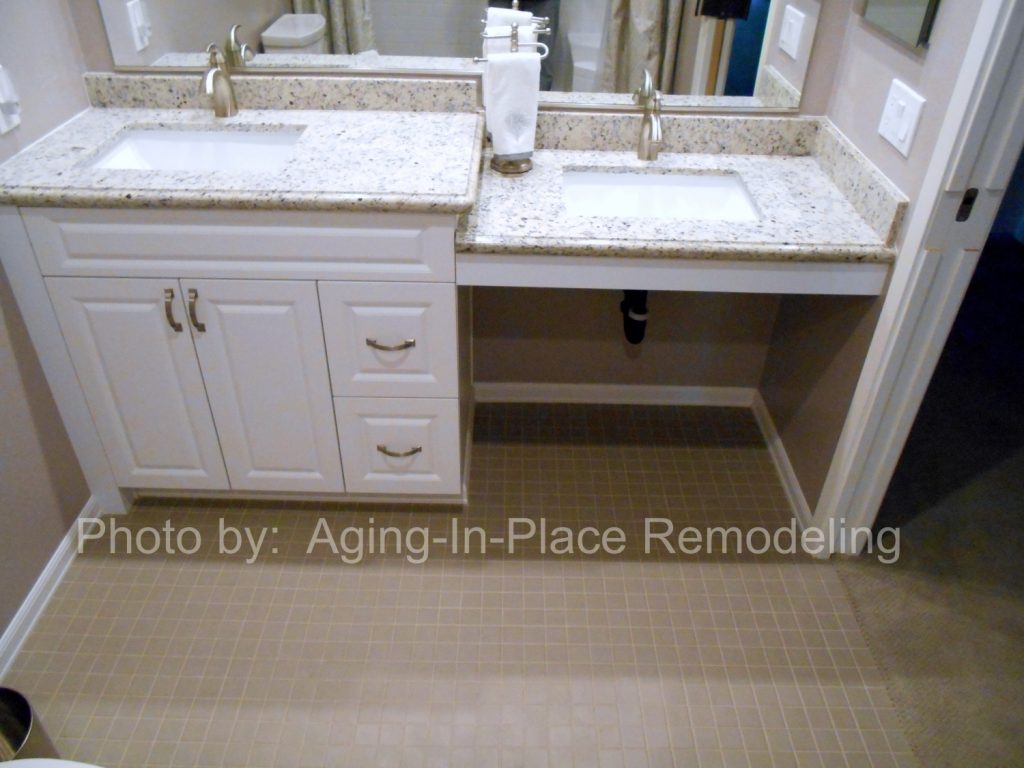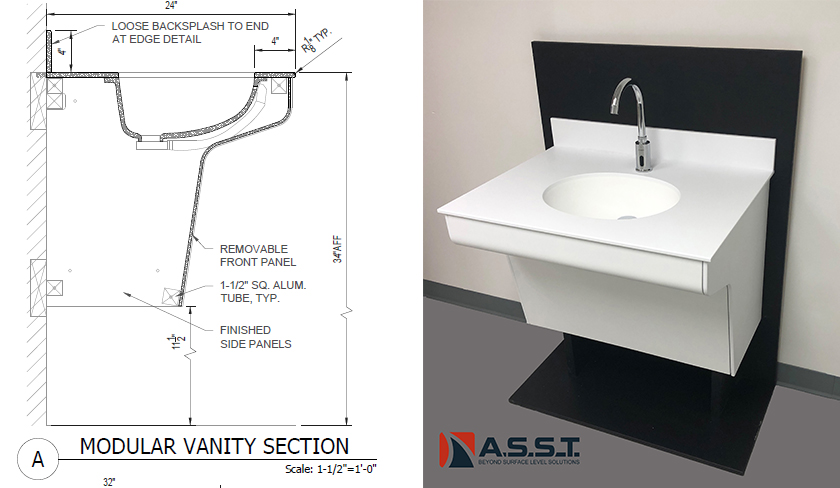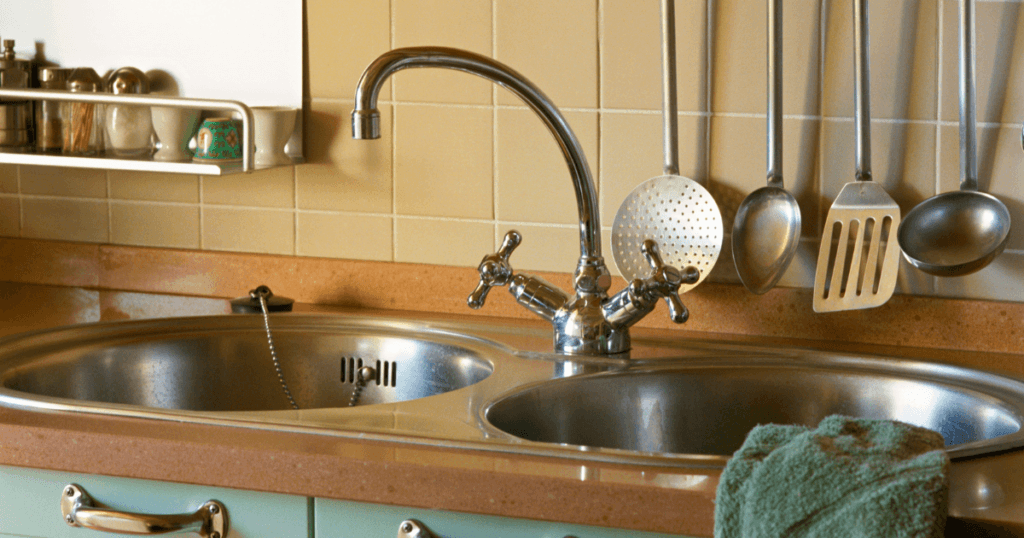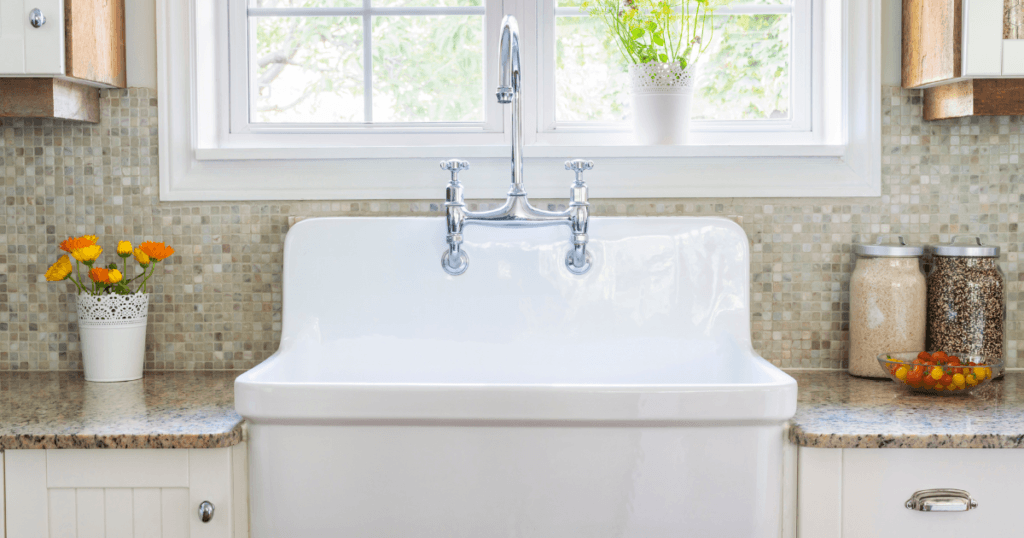If you or a loved one has mobility limitations, having an accessible bathroom is essential for maintaining independence and safety. A key component of an accessible bathroom is the sink, which should be functional and easy to use for people with disabilities. That's where ADA compliant bathroom sinks come in. These sinks are designed to meet the standards set by the Americans with Disabilities Act (ADA), ensuring that people with disabilities have equal access to bathroom amenities. In this article, we will explore the top 10 main handicapped bathroom sink height options to help you create a functional and accessible bathroom for your home.Achieve Accessibility with ADA Compliant Bathroom Sinks
One size does not fit all when it comes to accessible bathrooms. That's why adjustable height bathroom sinks are a great option for wheelchair users or individuals of varying heights. These sinks can be easily raised or lowered to the desired height, providing optimal accessibility for all users. Barrier-free sinks are also a popular choice, as they are designed to minimize obstacles and allow for easy wheelchair access. Accessible bathroom sinks, whether adjustable or barrier-free, promote independence and improve the overall functionality of the bathroom for people with disabilities.Customize Your Sink Height with Adjustable Height Bathroom Sinks
Universal design is the concept of creating products and environments that are usable by people of all ages and abilities. This design philosophy is especially important in bathrooms, where accessibility is crucial. Handicap accessible sinks, also known as wheelchair friendly sinks, are designed with universal design principles in mind. These sinks feature a lower height and open space underneath for wheelchair users to comfortably use the sink. They also typically have a lever handle faucet that can be operated with one hand, making it easier for individuals with limited dexterity to use the sink.Incorporate Universal Design with Handicap Accessible Sinks
One of the most important factors when choosing an accessible sink is the height. The ADA guidelines state that the top of the sink should be no higher than 34 inches from the floor, and the bottom should be no lower than 29 inches. This allows for easy reach and use for individuals in wheelchairs. Handicap sink height and wheelchair accessible sink height requirements may vary slightly, but the general height range remains the same. It's important to consider the individual needs of the user when determining the best sink height for your accessible bathroom.Understanding the Height Requirements for Accessible Sinks
The ADA has specific requirements for bathroom sinks to ensure they are accessible for individuals with disabilities. This includes the height requirement mentioned above, as well as the depth and clearance around the sink. The sink should also have a clear floor space of at least 30 inches by 48 inches in front of it for wheelchair maneuverability. Handicap bathroom sink dimensions may also vary, but they should still meet the ADA guidelines for accessibility. It's important to carefully consider the dimensions of the sink and the surrounding area to ensure it meets the requirements for accessibility.Meeting the ADA Requirements for Bathroom Sinks
Just because a sink is accessible, doesn't mean it has to sacrifice style. There are many options available for accessible bathroom sinks, including a variety of designs and styles. Handicap sink designs range from traditional to modern, and wheelchair accessible sink styles can be customized to fit any bathroom aesthetic. Some popular options for accessible sinks include wall-mounted sinks, pedestal sinks, and vanity sinks with open space underneath. It's important to choose a sink that not only meets your accessibility needs but also fits the overall look of your bathroom.Find the Perfect Accessible Sink for Your Bathroom
Installing an ADA compliant sink is crucial to ensure its accessibility and functionality. The sink should be mounted securely to the wall, and the plumbing should be installed in a way that does not block the user's knee or foot space. It's also important to consider the placement of the sink in relation to other bathroom fixtures to allow for easy maneuverability. Handicap sink mounting and wheelchair accessible sink placement may require some additional planning and consideration, but it's worth it to have a fully accessible bathroom for those with disabilities.Properly Install Your ADA Compliant Sink for Optimal Accessibility
In addition to the sink itself, it's important to choose the right hardware for optimal accessibility. Adjustable height sink faucets allow for easy operation for individuals with limited reach, while barrier-free sink fixtures minimize obstacles and promote independence for wheelchair users. Accessible bathroom sink hardware should also be easy to grasp and operate, such as lever handles or touchless faucets. These small details can make a big difference in the overall accessibility of the sink.Complete Your Accessible Sink with the Right Hardware
When choosing materials and finishes for your accessible sink, it's important to consider their impact on accessibility. For example, a sink with a polished finish may be difficult for individuals with visual impairments to see, while a matte finish may be easier to distinguish. Handicap sink finishes and wheelchair accessible sink materials should also be durable and easy to clean. Consider materials like stainless steel or porcelain, which are both durable and easy to maintain.Consider Accessibility When Choosing Sink Materials and Finishes
There are many accessories and add-ons available to enhance the functionality of your accessible sink. These can include features like a touchless soap dispenser, a pull-out sprayer for easier use, or a built-in towel holder for convenience. Handicap sink add-ons and wheelchair accessible sink features are not necessary, but they can make a big difference in the overall usability and independence of the sink for individuals with disabilities.Enhance Your Accessible Sink with Useful Accessories and Features
If you or a loved one has mobility limitations, having an accessible bathroom is essential for maintaining independence and safety. A key component of an accessible bathroom is the sink, which should be functional and easy to use for people with disabilities. That's where ADA compliant bathroom sinks come in. These sinks are designed to meet the standards set by the Americans with Disabilities Act (ADA), ensuring that people with disabilities have equal access to bathroom amenities. In this article, we will explore the top 10 main handicapped bathroom sink height options to help you create a functional and accessible bathroom for your home.Achieve Accessibility with ADA Compliant Bathroom Sinks
One size does not fit all when it comes to accessible bathrooms. That's why adjustable height bathroom sinks are a great option for wheelchair users or individuals of varying heights. These sinks can be easily raised or lowered to the desired height, providing optimal accessibility for all users. Barrier-free sinks are also a popular choice, as they are designed to minimize obstacles and allow for easy wheelchair access. Accessible bathroom sinks, whether adjustable or barrier-free, promote independence and improve the overall functionality of the bathroom for people with disabilities.Customize Your Sink Height with Adjustable Height Bathroom Sinks
Universal design is the concept of creating products and environments that are usable by people of all ages and abilities. This design philosophy is especially important in bathrooms, where accessibility is crucial. Handicap accessible sinks, also known as wheelchair friendly sinks, are designed with universal design principles in mind. These sinks feature a lower height and open space underneath for wheelchair users to comfortably use the sink. They also typically have a lever handle faucet that can be operated with one hand, making it easier for individuals with limited dexterity to use the sink.Incorporate Universal Design with Handicap Accessible Sinks
One of the most important factors when choosing an accessible sink is the height. The ADA guidelines state that the top of the sink should be no higher than 34 inches from the floor, and the bottom should be no lower than 29 inches. This allows for easy reach and use for individuals in wheelchairs. Handicap sink height and wheelchair accessible sink height requirements may vary slightly, but the general height range remains the same. It's important to consider the individual needs of the user when determining the best sink height for your accessible bathroom.Understanding the Height Requirements for Accessible Sinks
The ADA has specific requirements for bathroom sinks to ensure they are accessible for individuals with disabilities. This includes the height requirement mentioned above, as well as the depth and clearance around the sink. The sink should also have a clear floor space of at least 30 inches by 48 inches in front of it for wheelchair maneuverability. Handicap bathroom sink dimensions may also vary, but they should still meet the ADA guidelines for accessibility. It's important to carefully consider the dimensions of the sink and the surrounding area to ensure it meets the requirements for accessibility.Meeting the ADA Requirements for Bathroom Sinks
Just because a sink is accessible, doesn't mean it has to sacrifice style. There are many options available for accessible bathroom sinks, including a variety of designs and styles. Handicap sink designs range from traditional to modern, and wheelchair accessible sink styles can be customized to fit any bathroom aesthetic. Some popular options for accessible sinks include wall-mounted sinks, pedestal sinks, and vanity sinks with open space underneath. It's important to choose a sink that not only meets your accessibility needs but also fits the overall look of your bathroom.Find the Perfect Accessible Sink for Your Bathroom
Installing an ADA compliant sink is crucial to ensure its accessibility and functionality. The sink should be mounted securely to the wall, and the plumbing should be installed in a way that does not block the user's knee or foot space. It's also important to consider the placement of the sink in relation to other bathroom fixtures to allow for easy maneuverability. Handicap sink mounting and wheelchair accessible sink placement may require some additional planning and consideration, but it's worth it to have a fully accessible bathroom for those with disabilities.Properly Install Your ADA Compliant Sink for Optimal Accessibility
In addition to the sink itself, it's important to choose the right hardware for optimal accessibility. Adjustable height sink faucets allow for easy operation for individuals with limited reach, while barrier-free sink fixtures minimize obstacles and promote independence for wheelchair users. Accessible bathroom sink hardware should also be easy to grasp and operate, such as lever handles or touchless faucets. These small details can make a big difference in the overall accessibility of the sink.Complete Your Accessible Sink with the Right Hardware
When choosing materials and finishes for your accessible sink, it's important to consider their impact on accessibility. For example, a sink with a polished finish may be difficult for individuals with visual impairments to see, while a matte finish may be easier to distinguish. Handicap sink finishes and wheelchair accessible sink materials should also be durable and easy to clean. Consider materials like stainless steel or porcelain, which are both durable and easy to maintain.Consider Accessibility When Choosing Sink Materials and Finishes
There are many accessories and add-ons available to enhance the functionality of your accessible sink. These can include features like a touchless soap dispenser, a pull-out sprayer for easier use, or a built-in towel holder for convenience. Handicap sink add-ons and wheelchair accessible sink features are not necessary, but they can make a big difference in the overall usability and independence of the sink for individuals with disabilities.Enhance Your Accessible Sink with Useful Accessories and Features
Why Handicapped Bathroom Sink Height Matters in House Design

The Importance of Accessibility in Home Design
 When designing a house, it is important to consider the needs of all individuals who will be living in or visiting the home. This includes individuals with disabilities who may have specific requirements for accessibility. One crucial aspect of accessibility in house design is the
handicapped bathroom sink height
. This may seem like a small detail, but it can make a big difference for someone with a disability.
When designing a house, it is important to consider the needs of all individuals who will be living in or visiting the home. This includes individuals with disabilities who may have specific requirements for accessibility. One crucial aspect of accessibility in house design is the
handicapped bathroom sink height
. This may seem like a small detail, but it can make a big difference for someone with a disability.
The Standard Height for a Handicapped Bathroom Sink
 According to the Americans with Disabilities Act (ADA), the standard height for a
handicapped bathroom sink
is between 29-34 inches from the floor. This allows for easier access for individuals who use wheelchairs or other mobility aids. The ADA also requires that the sink be no more than 6 inches from the front edge of the counter to allow for enough space for a wheelchair to fit underneath.
According to the Americans with Disabilities Act (ADA), the standard height for a
handicapped bathroom sink
is between 29-34 inches from the floor. This allows for easier access for individuals who use wheelchairs or other mobility aids. The ADA also requires that the sink be no more than 6 inches from the front edge of the counter to allow for enough space for a wheelchair to fit underneath.
Why Handicapped Bathroom Sink Height Matters
 Not only is it important for individuals with disabilities to have equal access to a bathroom, but it also promotes independence and dignity. By having a
handicapped bathroom sink
at the appropriate height, individuals with disabilities can perform tasks such as washing their hands and brushing their teeth without assistance. This small detail can greatly impact the daily lives of those with disabilities, allowing them to feel more comfortable and confident in their own home.
Not only is it important for individuals with disabilities to have equal access to a bathroom, but it also promotes independence and dignity. By having a
handicapped bathroom sink
at the appropriate height, individuals with disabilities can perform tasks such as washing their hands and brushing their teeth without assistance. This small detail can greatly impact the daily lives of those with disabilities, allowing them to feel more comfortable and confident in their own home.
Incorporating Handicapped Bathroom Sink Height into House Design
 When designing a house, it is crucial to plan for accessibility from the beginning. This includes considering the placement and height of bathroom sinks to accommodate individuals with disabilities. There are various
bathroom sink options
available that meet the ADA standards, including wall-mounted sinks and pedestal sinks. It is important to consult with a professional designer or contractor to ensure that the sink is installed at the appropriate height for accessibility.
When designing a house, it is crucial to plan for accessibility from the beginning. This includes considering the placement and height of bathroom sinks to accommodate individuals with disabilities. There are various
bathroom sink options
available that meet the ADA standards, including wall-mounted sinks and pedestal sinks. It is important to consult with a professional designer or contractor to ensure that the sink is installed at the appropriate height for accessibility.
In Conclusion
 In house design, every detail matters, especially when it comes to accessibility. The
handicapped bathroom sink height
may seem like a small detail, but it can greatly impact the daily lives of individuals with disabilities. By incorporating the appropriate height for a handicapped bathroom sink into house design, we can promote equal access and independence for all individuals.
In house design, every detail matters, especially when it comes to accessibility. The
handicapped bathroom sink height
may seem like a small detail, but it can greatly impact the daily lives of individuals with disabilities. By incorporating the appropriate height for a handicapped bathroom sink into house design, we can promote equal access and independence for all individuals.
























































































































































